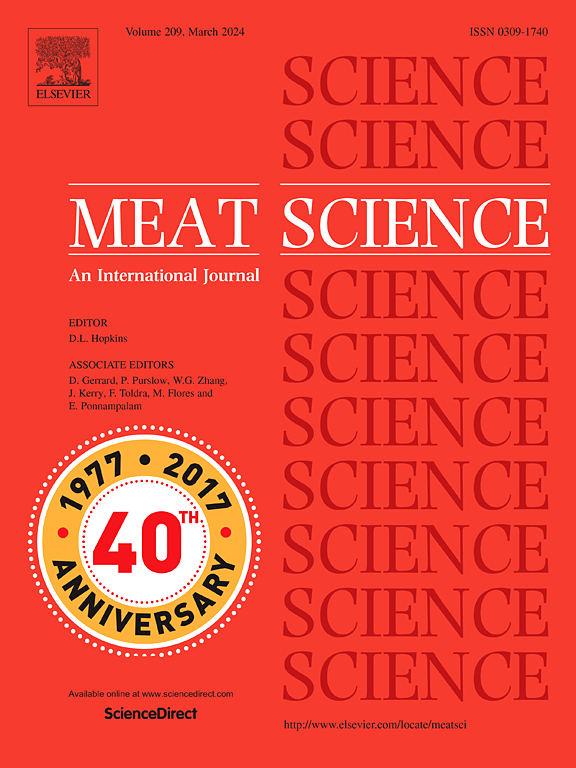Effects of vegetable extracts on the formation of heterocyclic aromatic amines and advanced glycation end products during roasting and in vitro digestion of roasted beef patties
IF 6.1
1区 农林科学
Q1 Agricultural and Biological Sciences
引用次数: 0
Abstract
The research explored the effect of tomato, carrot, and lettuce extracts on the formation of heterocyclic aromatic amines (HAAs) and advanced glycation end products (AGEs) in beef patties during roasting and in vitro digestion. Carrot extract had strongest inhibitory effects on HAAs and AGEs formation, reducing total free HAAs (21.01 %), free AGEs (12.29 %), bound HAAs (28.20 %), and bound AGEs (9.65 %), relative to the control sample (P < 0.05). Carrot extract inhibited the formation of free AαC, Norharman, and CML, as well as bound 7,8-DiMeIQx, Glu-P-2, Harman, Norharman, and CEL (P < 0.05). Consumption of lettuce with roasted beef patties increased intestinal exposure to total HAAs, while tomato and carrot extracts had no significant effect on intestinal total HAAs exposure. However, three vegetable extracts increased intestinal exposure to total AGEs. Molecular docking revealed that β-carotene inhibited the formation of bound HAAs and AGEs by competing with creatine for TYR-1783, with MTCA for TYR-1783 and LYS-2025, and with THCA for LYS-2025, ALA-2029, and TYR-1783 on bovine myosin. These results offer insights into controlling hazardous compound formation in roasted meat products.
蔬菜提取物对烤牛肉饼烘烤和体外消化过程中杂环芳香胺和晚期糖基化终产物形成的影响
研究了番茄、胡萝卜和生菜提取物对牛肉饼烘烤和体外消化过程中杂环芳香胺(HAAs)和晚期糖基化终产物(AGEs)形成的影响。胡萝卜提取物对HAAs和AGEs形成的抑制作用最强,与对照样品相比,总游离HAAs(21.01%)、游离AGEs(12.29%)、结合HAAs(28.20%)和结合AGEs(9.65%)均降低(P <;0.05)。胡萝卜提取物抑制游离AαC、Norharman和CML的形成,以及结合的7,8- dimeiqx、Glu-P-2、Harman、Norharman和CEL (P <;0.05)。食用生菜和烤牛肉饼增加了肠道总HAAs暴露量,而番茄和胡萝卜提取物对肠道总HAAs暴露量无显著影响。然而,三种蔬菜提取物增加了肠道对总AGEs的暴露。分子对接发现,β-胡萝卜素通过与肌酸竞争酪氨酸-1783,与MTCA竞争酪氨酸-1783和赖氨酸-2025,与THCA竞争赖氨酸-2025、ALA-2029和赖氨酸-1783,抑制牛肌球蛋白结合的HAAs和AGEs的形成。这些结果为控制烤肉产品中有害化合物的形成提供了见解。
本文章由计算机程序翻译,如有差异,请以英文原文为准。
求助全文
约1分钟内获得全文
求助全文
来源期刊

Meat Science
工程技术-食品科技
CiteScore
12.60
自引率
9.90%
发文量
282
审稿时长
60 days
期刊介绍:
The aim of Meat Science is to serve as a suitable platform for the dissemination of interdisciplinary and international knowledge on all factors influencing the properties of meat. While the journal primarily focuses on the flesh of mammals, contributions related to poultry will be considered if they enhance the overall understanding of the relationship between muscle nature and meat quality post mortem. Additionally, papers on large birds (e.g., emus, ostriches) as well as wild-captured mammals and crocodiles will be welcomed.
 求助内容:
求助内容: 应助结果提醒方式:
应助结果提醒方式:


